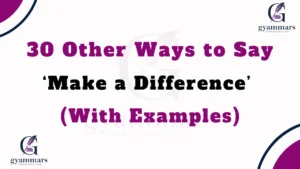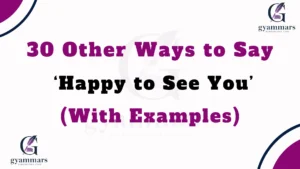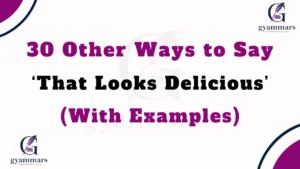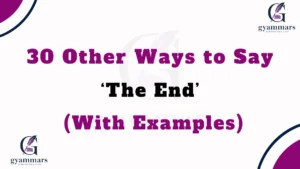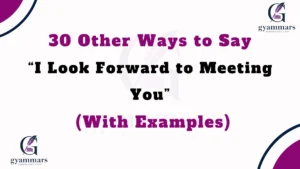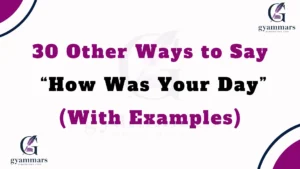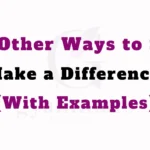Finding the right words can change how your message feels—whether you’re writing an email, telling a story, or having a heartfelt conversation. Sometimes, a simple phrase like “on the other hand” can feel too plain or repetitive. By exploring thoughtful alternatives, you can bring warmth, care, and variety to your communication. This guide gives you 30 empathetic and conversational substitutes, along with examples, tones, and best-use notes to help you express yourself more meaningfully.
What Does “On The Other Hand” Mean?
The phrase “on the other hand” is commonly used to introduce contrast or an opposing idea. It signals to the listener or reader that you’re about to present another side of the discussion.
Is It Professional/Polite to Say “On The Other Hand”?
Yes, “on the other hand” is both professional and polite. It works in conversations, business emails, academic writing, and casual dialogue. However, using it too often may make your speech or writing sound repetitive, which is why having alternatives can elevate your communication.
Pros or Cons of Using “On The Other Hand”
Pros:
- Universally understood
- Professional and clear
- Easy to use in both writing and speech
Cons:
- Can sound repetitive if overused
- Slightly formal, may feel stiff in casual settings
- Lacks emotional warmth compared to alternatives
Synonyms For ‘On The Other Hand’
- Conversely
- In Contrast
- However
- That Said
- Yet
- On the Flip Side
- Still
- All the Same
- Even So
- At the Same Time
- In Opposition
- Instead
- But Then Again
- Nevertheless
- Whereas
- Though
- While
- On the Contrary
- Differently
- Alternatively
- From Another Perspective
- Looking at It Differently
- On a Different Note
- Otherwise
- Rather
- Then Again
- Oppositely
- Contrarily
- On Balance
- In Another Light
1. Conversely
Definition: Expresses the opposite of what was just stated.
Detailed Explanation: A formal word often used in academic or professional writing.
Scenario Example: “I enjoy city life. Conversely, I sometimes miss the quiet of the countryside.”
Best Use: Formal writing, professional emails, debates.
Tone: Neutral, professional.
Additional Notes: Works best in structured, logical writing.
2. In Contrast
Definition: Highlights a clear difference between two things.
Detailed Explanation: Emphasizes distinction directly.
Scenario Example: “Her work is detail-oriented. In contrast, mine is more big-picture.”
Best Use: Essays, comparisons, and analysis.
Tone: Objective.
Additional Notes: Stronger than “on the other hand.”
3. However
Definition: Introduces a contrasting idea or exception.
Detailed Explanation: A flexible word for spoken and written communication.
Scenario Example: “I love mornings. However, I often stay up too late at night.”
Best Use: Professional and casual contexts.
Tone: Neutral.
Additional Notes: Polished yet simple alternative.
4. That Said
Definition: Acknowledges one point before introducing another.
Detailed Explanation: Softer than “however,” conversational.
Scenario Example: “The movie was long. That said, it was beautifully filmed.”
Best Use: Casual or friendly writing.
Tone: Warm, conversational.
Additional Notes: Great for balancing perspectives gently.
5. Yet
Definition: Shows contradiction or contrast.
Detailed Explanation: A concise way to present an opposing idea.
Scenario Example: “She’s shy, yet she’s a strong public speaker.”
Best Use: Everyday conversation and storytelling.
Tone: Neutral.
Additional Notes: Works well for shorter sentences.
6. On the Flip Side
Definition: Informal phrase for presenting an opposite view.
Detailed Explanation: Casual, friendly, and light.
Scenario Example: “I love summer. On the flip side, winter has its charm.”
Best Use: Informal conversation or casual writing.
Tone: Friendly, lighthearted.
Additional Notes: Not ideal for professional emails.
7. Still
Definition: Suggests that a statement remains true despite contrast.
Detailed Explanation: Simple and commonly used in speech.
Scenario Example: “The hike was tough. Still, it was worth the effort.”
Best Use: Conversations, storytelling.
Tone: Casual, reflective.
Additional Notes: Works well for thoughtful pauses.
8. All the Same
Definition: Despite what’s been said, another point remains valid.
Detailed Explanation: Brings balance while keeping it conversational.
Scenario Example: “I don’t usually enjoy action movies. All the same, this one was exciting.”
Best Use: Friendly exchanges.
Tone: Warm, conversational.
Additional Notes: Slightly old-fashioned but still effective.
9. Even So
Definition: Acknowledges one fact while presenting a contrary idea.
Detailed Explanation: Adds nuance to everyday language.
Scenario Example: “It was raining. Even so, we decided to go hiking.”
Best Use: Balanced discussions.
Tone: Gentle, reflective.
Additional Notes: Smooth and empathetic alternative.
10. At the Same Time
Definition: Expresses two opposing truths together.
Detailed Explanation: Good for balancing without dismissing either side.
Scenario Example: “I love my job. At the same time, it can be stressful.”
Best Use: Both personal and professional contexts.
Tone: Neutral, thoughtful.
Additional Notes: Shows acceptance of both sides.
11. In Opposition
Definition: Expresses an idea that directly goes against another.
Detailed Explanation: Stronger than “on the other hand,” it clearly frames a statement as opposing.
Scenario Example: “She supports the new policy. In opposition, many employees feel it adds unnecessary pressure.”
Best Use: Formal debates, professional discussions.
Tone: Formal, assertive.
Additional Notes: Use carefully—it may sound confrontational.
12. Instead
Definition: Suggests choosing one option over another.
Detailed Explanation: Clear and simple way to present alternatives.
Scenario Example: “I didn’t take the train. I drove instead.”
Best Use: Both formal and casual communication.
Tone: Direct, neutral.
Additional Notes: Strong substitute when showing preference.
13. But Then Again
Definition: Introduces a counterpoint with a casual tone.
Detailed Explanation: Relaxed way of reconsidering or softening a statement.
Scenario Example: “The restaurant looks expensive. But then again, the food might be worth it.”
Best Use: Casual conversations, storytelling.
Tone: Friendly, reflective.
Additional Notes: Works when weighing pros and cons aloud.
14. Nevertheless
Definition: Means “in spite of that.”
Detailed Explanation: A polished way to acknowledge a point but continue with contrast.
Scenario Example: “The project was challenging. Nevertheless, we completed it on time.”
Best Use: Professional writing, formal discussions.
Tone: Polished, professional.
Additional Notes: Great for academic or persuasive work.
15. Whereas
Definition: Introduces a contrast between two things.
Detailed Explanation: Often used in comparisons to show difference.
Scenario Example: “Cats are independent, whereas dogs need more attention.”
Best Use: Academic, analytical writing.
Tone: Objective, factual.
Additional Notes: Strong in structured arguments.
16. Though
Definition: Adds a contrasting point, often casually.
Detailed Explanation: Flexible word, often used at the end of a sentence.
Scenario Example: “The movie was long. Good, though.”
Best Use: Informal conversation.
Tone: Casual, light.
Additional Notes: Short and effective for spoken English.
17. While
Definition: Expresses contrast in a sentence.
Detailed Explanation: Common in both formal and informal language.
Scenario Example: “While the plan is costly, it’s also very effective.”
Best Use: Balanced writing, professional reports.
Tone: Neutral, thoughtful.
Additional Notes: Adds elegance to comparisons.
18. On the Contrary
Definition: States the opposite of what was suggested.
Detailed Explanation: Stronger than “on the other hand,” emphasizes disagreement.
Scenario Example: “You think he’s unfriendly? On the contrary, he’s very kind.”
Best Use: Correcting or clarifying misconceptions.
Tone: Firm, corrective.
Additional Notes: Good for polite disagreement.
19. Differently
Definition: Introduces another perspective or approach.
Detailed Explanation: Invites readers/listeners to think from another angle.
Scenario Example: “Let’s look at this problem differently—what if we tried a new strategy?”
Best Use: Brainstorming, creative discussions.
Tone: Open, thoughtful.
Additional Notes: Encourages flexibility.
20. Alternatively
Definition: Presents another option or choice.
Detailed Explanation: Formal but approachable; useful in decisions.
Scenario Example: “We could go hiking. Alternatively, we could spend the day in town.”
Best Use: Professional, academic, or casual options.
Tone: Neutral, practical.
Additional Notes: Great for structured options.
21. From Another Perspective
Definition: Suggests seeing the issue differently.
Detailed Explanation: Invites empathy or understanding.
Scenario Example: “From another perspective, the decision was actually beneficial.”
Best Use: Coaching, reflective conversations.
Tone: Empathetic, thoughtful.
Additional Notes: Encourages open-mindedness.
Also Read This : 30 Other Ways to Say ‘The End’ in A Story (With Examples)
22. Looking at It Differently
Definition: Casual way to reframe an issue.
Detailed Explanation: Similar to “from another perspective,” but less formal.
Scenario Example: “Looking at it differently, the delay gave us more time to prepare.”
Best Use: Friendly conversations, coaching.
Tone: Warm, casual.
Additional Notes: Works well when trying to uplift or reassure.
23. On a Different Note
Definition: Switches the topic slightly.
Detailed Explanation: More about shifting focus than direct opposition.
Scenario Example: “We’ve talked about challenges. On a different note, let’s celebrate progress.”
Best Use: Casual or professional meetings.
Tone: Smooth, conversational.
Additional Notes: Useful for transitions.
24. Otherwise
Definition: Shows what might happen if the opposite occurs.
Detailed Explanation: Often used to suggest alternatives or consequences.
Scenario Example: “You must finish the task now. Otherwise, we’ll miss the deadline.”
Best Use: Instructions, guidance.
Tone: Clear, directive.
Additional Notes: Practical and straightforward.
25. Rather
Definition: Suggests preference for one option over another.
Detailed Explanation: A softer way of presenting alternatives.
Scenario Example: “I’d rather take the train than drive.”
Best Use: Conversations, polite refusals.
Tone: Polite, gentle.
Additional Notes: Common in both British and American English.
26. Then Again
Definition: Introduces reconsideration of a point.
Detailed Explanation: Friendly phrase for weighing both sides.
Scenario Example: “The job pays well. Then again, it requires long hours.”
Best Use: Casual dialogue, reflective tone.
Tone: Light, balanced.
Additional Notes: Works for thoughtful pauses.
27. Oppositely
Definition: Means “in the opposite way.”
Detailed Explanation: Direct alternative but less commonly used.
Scenario Example: “She sees it positively. He, oppositely, finds it difficult.”
Best Use: Formal, though rare.
Tone: Neutral, precise.
Additional Notes: Less natural in spoken English.
28. Contrarily
Definition: Expresses opposition in a strong way.
Detailed Explanation: More formal; signals direct contradiction.
Scenario Example: “Many believe the policy helps. Contrarily, some argue it harms.”
Best Use: Academic writing, debates.
Tone: Strong, formal.
Additional Notes: Can sound old-fashioned.
29. On Balance
Definition: Weighs both sides before a conclusion.
Detailed Explanation: Suggests overall consideration.
Scenario Example: “There are challenges. On balance, it’s still a good decision.”
Best Use: Formal conclusions, decision-making.
Tone: Thoughtful, reflective.
Additional Notes: Great for closing comparisons.
30. In Another Light
Definition: Suggests viewing something from a fresh angle.
Detailed Explanation: Invites rethinking or reinterpreting.
Scenario Example: “Seen in another light, the mistake was a learning opportunity.”
Best Use: Coaching, positive reframing.
Tone: Empathetic, uplifting.
Additional Notes: Excellent for encouragement.
Conclusion
By exploring these 30 alternatives to “on the other hand,” you can bring greater nuance, professionalism, or warmth to your words. Some are formal and polished, while others are casual and caring, but all help you avoid repetition and connect with your audience in a meaningful, thoughtful way.
FAQs:
1. What is the simplest replacement for “on the other hand”?
Words like yet or however work best.
2. Which alternative is most formal?
Conversely and nevertheless are the most formal.
3. Which phrase feels the most empathetic?
From another perspective or in another light add empathy.
4. Can I use “on the flip side” in professional writing?
It’s best saved for casual contexts, not formal documents.
5. Why should I vary my language?
It makes your writing or speech feel fresh, engaging, and more personal.

“Mia Rose at Grammar Synonyms is your ultimate guide to mastering language with style and precision. Whether you’re looking to enhance your vocabulary, perfect your grammar, or discover the ideal synonym, Mia Rose offers expert resources and creative solutions to help you express yourself flawlessly. With Grammar Synonyms, unlock a world of language possibilities and elevate every piece of writing you create.
